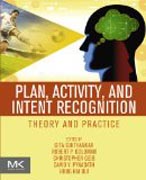
Plan, Activity, and Intent Recognition: Theory and Practice
Sukthankar, Gita
Geib, Christopher
Bui, Hung Hai
Pynadath, David
Goldman, Robert P.
Plan recognition, activity recognition, and intent recognition together combine and unify techniques from user modeling, machine vision, intelligent user interfaces, human/computer interaction, autonomous and multi-agent systems, natural language understanding, and machine learning. Plan, Activity, and Intent Recognition explains the crucial role of these techniques in a wide variety of applications including: . personal agent assistants . computer and network security . opponent modeling in games and simulation systems . coordination in robots and software agents . web e-commerce and collaborative filtering . dialog modeling . video surveillance . smart homes In this book, follow the history of this research area and witness exciting new developments in the field made possible by improved sensors, increased computational power, and new application areas. Combines basic theory on algorithms for plan/activity recognition along with results from recent workshops and seminarsExplains how to interpret and recognize plans and activities from sensor dataProvides valuable background knowledge and assembles key concepts into one guide for researchers or students studying these disciplines INDICE: Introduction Plan and Goal Recognition 1) Hierarchical Goal Recognition 2) Weighted Abduction for Discourse Processing Based on Integer Linear Programming 3) Plan Recognition using Statistical Relational Models 4) Keyhole Adversarial Plan Recognition for Recognition of Suspicious and Anomalous Behavior Activity Discovery and Recognition 5) Scaling Activity Recognition 6) Extraction of Latent Patterns and Contexts from Social Honest Signals Using Hierarchical Dirichlet Processes Modeling Human Cognition 7) Modeling Human Plan Recognition using Bayesian Theory of Mind 8) Decision Theoretic Planning in Multiagent Settings with Application to Modeling Human Strategic Behavior Multiagent Systems 9) Multiagent Plan Recognition from Partially Observed Team Traces 10) Role-based Ad Hoc Teamwork Applications 11) Probabilistic plan recognition for proactive assistant agents 12) Recognizing Player Goals in Open-Ended Digital Games with Markov Logic Networks 13) Using Opponent Modeling to Adapt Team Play in American Football 14) Intent Recognition for Human-Robot Interaction
- ISBN: 978-0-12-398532-3
- Editorial: Morgan Kaufmann
- Encuadernacion: Rústica
- Páginas: 416
- Fecha Publicación: 12/04/2014
- Nº Volúmenes: 1
- Idioma: Inglés
